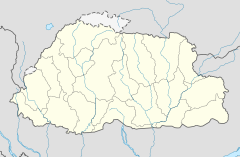Royal Manas National Park
| Royal Manas National Park | ||
|---|---|---|
| The entrance to the park | ||
|
|
||
| Location: | Bhutan | |
| Surface: | 1057 km² | |
| Founding: | 1966 | |
| National park map | ||
The Royal Manas National Park is a national park in Bhutan . It was founded in 1966 , making it the oldest in the country . With an area of 1057 km² it covers areas in a total of three districts of the country. Among them is the eastern part of the Sarpang district , the western part of the Zhemgang district and the western part of the Pemagatshel district .
The national park is connected to the Jigme Singye Wangchuck National Park , Phipsoo Reserve , Phrumsengla National Park and Khaling Wildlife Sanctuary , other national parks in Bhutan, via "biological corridors" .
In the south, the Royal Manas National Park borders the Manas National Park , a UNESCO World Heritage Site in India.
climate
In the monsoon season from May to September , up to 5000 mm of rain can fall in the national park . In the other parts of the year there is little rain. The best travel time is from November to March , as the temperatures are very pleasant during this time .
history
In 1966, Royal Manas was designated as a Wildlife Sanctuary, making it the oldest nature reserve in Bhutan . In 1993 the area was finally declared a national park.
Flora and fauna
The Royal Manas National Park is home to countless rare plants and animals .
flora
Habitats (habitat of a certain animal species) range in the Royal Manas National Park from lowland tropical forests to permanent ice fields .
fauna
The Royal National Park is home to Bengal tigers , Asian elephants , Gaurs ( Bos gaurus ), as well as rarer golden langurs ( Presbytis geei ), dwarf wild boars ( Sus salvanius ), bristle rabbits ( Caprolagus hispidus ) and Ganges dolphins ( Platanista gangetica ). It is also the only Bhutanese national park that is inhabited by the Indian rhinoceros ( Rhinoceros unicornis ) and the white water buffalo ( Bubalus arnee ).
More than 426 different bird species have already been spotted in the national park. It is assumed, however, that there are more than 200 more in the park. The globally threatened species such as the hornbill , the black sea eagle , the second largest species of heron, the imperial heron , spotted chested dwarf males , mountain rattle and the magnificent cuckoo also live here .
The Manas and its tributaries are home to three rare species of carp fish ( Tor tor , Tor putitora and Acrossocheilus hexangonolepis ).
In addition, the park is home to more than 900 different plant species, which we find today, for example, in medicine . But these plants are also used on religious occasions.
Web links
Individual evidence
- ^ Bhutan Trust Fund. Retrieved September 10, 2017 (American English).
- ^ Bhutan Royal Manas National Park - Royal Manas Wildlife Sanctuary in Bhutan. Retrieved September 10, 2017 .
- ^ Royal Manas National Park (RMNP) . ( org.bt [accessed September 10, 2017]).



